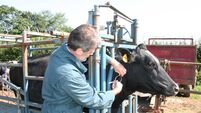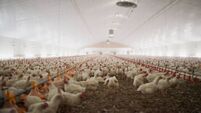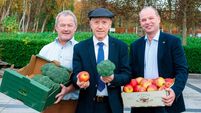Clouds could have a silver lining for Irish farmers
It will take our agriculture a while to recover from our wettest summer in 50 years. But there could be a bright side for Ireland to look at, in the major global weather disaster of the year — the worst drought the US has seen in nearly a century.
That has left a 165 million tonnes hole in global grain and oilseed supplies, which had already been at tight levels.
As a result, prices for grains and oilseeds will remain high for at least the next year.
Rabobank says world maize stocks will fall to only 51 days of use next year, and world soybean stocks will fall to only 73 days.
That means feed cost increases on livestock farms around the world, driving down production of cattle, milk, pigmeat, and poultry — at the same time as demand for food increases, due to population growth and economic recovery.
According to researchers at Rabobank, skyrocketing agricultural commodity prices are causing the world to re-enter a period of agflation, with food prices forecast to reach new record highs in 2013.
The Food and Agriculture Organisation of the United Nations also expects global food prices to rise to new record levels in 2013. And here at home, Bord Bia also predicts rising meat and dairy commodity prices, which will boost the value of Irish food exports in 2013 and beyond.
Only pasture-based production regions such as New Zealand and Ireland can hope to escape the full effect of high animal feed prices — and thus take advantage of high global food prices.
In the longer term, Ireland looks like one of the regions where agriculture is most sustainable.
In other regions, extreme weather has a bigger effect on the ability of farmers to respond to increased demand. New findings from the National Aeronautics and Space Administration (NASA) in the US show summer temperatures and volatility increasing uniformly since the 1960s, bringing increased weather risks during early phases of the crop growing season — heralding continuing grain price shocks.
As a result, a longer term trend of grain and oilseed consumption surpassing production has set in, with production outpacing supply only in five of the 13 marketing years so far this century.
Even the largest grain and oilseed harvest ever in 2008/09 was not sufficient to rebuild depleted global stocks.
Over the past five seasons, low stocks have left the market without any buffer against adverse growing conditions, such as in the US this year, where it is forecast that maize production will be 29% below the expected yield, despite record plantings.
So global food prices are set to reach their third peak in just five years, confirming the extreme volatility of the global food market.
Ireland is seeking to turn this into a commercial advantage, by emphasising the sustainability of our food industry.
Of course, our sustainability depends on our farmers overcoming the setbacks of 2012.
This means taking full advantage of grass-based farming, reducing the bill for expensive purchased feeds for livestock — an ever-rising bill, due to grain shortages.
Our farmers also have to overcome obstacles like the high fertiliser prices which are linked with high energy prices, and remain a key cost of agricultural production.
Farmers in other countries face the same obstacle but only countries like Ireland can consistently and sustainably grow the grass which replaces the purchased feed now becoming unaffordable for millions of livestock farmers worldwide.












